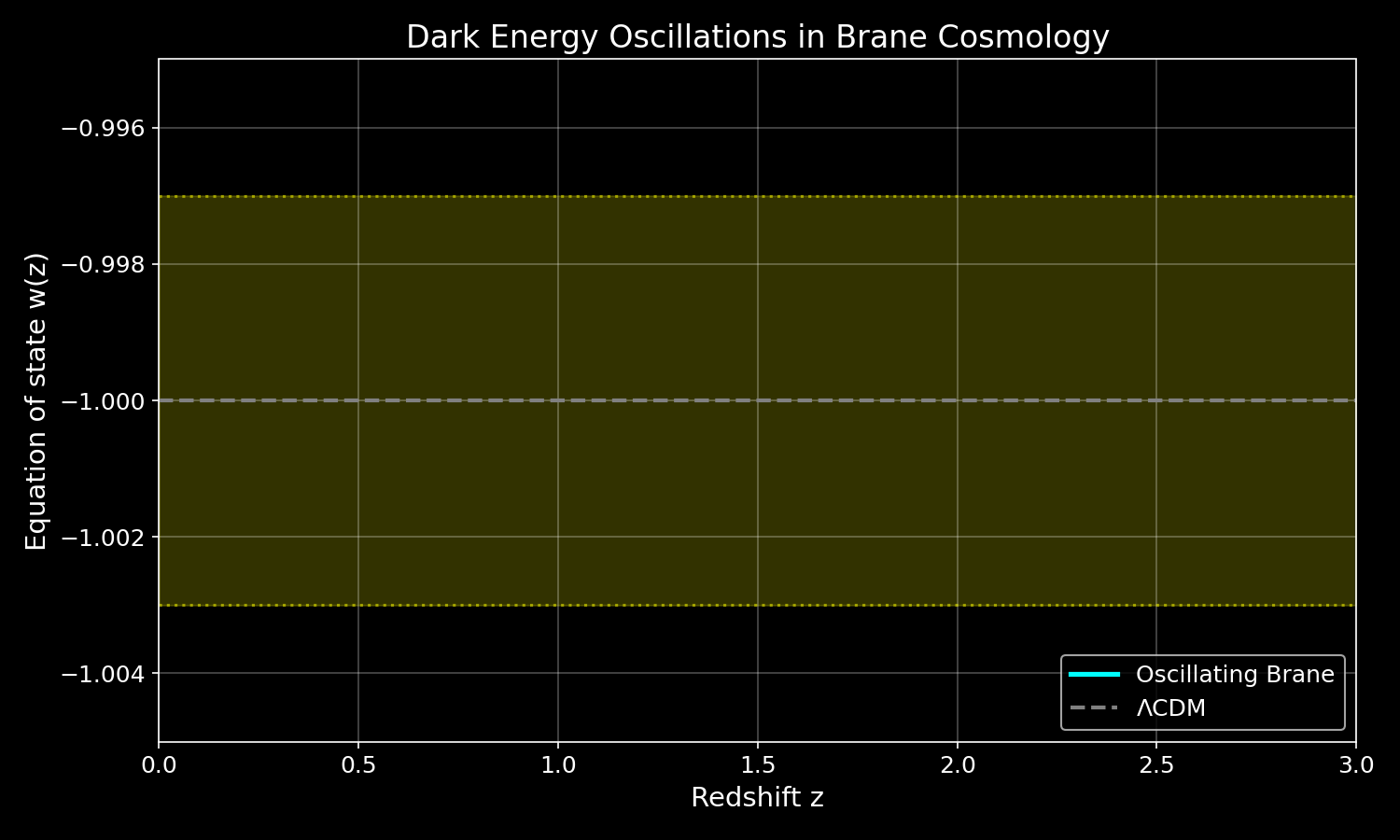Complete Theoretical Framework
The oscillating brane dark matter theory represents a paradigm shift in our understanding of the cosmos. Here we present the complete mathematical framework and physical insights.
Core Concepts
The Brane Universe
Our 4D spacetime is an elastic membrane floating in a 5D bulk. This isn’t merely a mathematical abstraction—it’s the fundamental nature of reality.
Gravitational Funnels
Black holes serve as conduits between our brane and the bulk, allowing dark matter to oscillate through the extra dimension.
Fundamental Oscillation
The entire universe vibrates as a single entity with a period of approximately 2 billion years, creating the effects we attribute to dark energy.
Mathematical Framework
Microscopic Excitation
The surface pressure induced by dark matter impacts writes:
\[\Pi(t) = \sum_i \dot{N}_i m_{MN} v_{\perp} \simeq f_{osc} \rho_{DM} v_{\perp}^2 [1 + \sin(\omega_0 t)]\]Key features:
- Coherent phase: Bulk crossing time ≪ 1 Gyr ensures identical phase across the sky
- ℓ=0 selectivity: The coupling integral \(\int Y_{\ell m} d\Omega\) vanishes for ℓ > 0
- Fundamental mode dominance: Only the spherically symmetric mode is excited
Energy of the Membrane
The deformation energy of the cosmic membrane is:
\[E_{tens} = \frac{1}{2} τ_0 A \left(\frac{2πz}{λ}\right)^2\]Where:
- τ₀ = 7.0 × 10¹⁹ J/m² is the brane tension
- A ≃ R_H² is the area of the observable universe
- z is the displacement in the extra dimension
- λ ≃ 2R_H is the fundamental wavelength
Dark Energy Equation of State
The oscillating membrane creates a time-varying dark energy:
\[w(z) = -1 + A_w \sin\left(\frac{2π t_{lb}(z)}{T}\right)\]With amplitude A_w ≃ 0.003 and period T = 2.0 Gyr.
Key insight: Though the amplitude is small (±0.3%), w oscillates between ≈ -1.003 and -0.997. This subtle variation is sufficient to:
- Suppress structure growth by 5.2%
- Resolve the S₈ tension
- Be detectable by Euclid at >5σ significance
 Figure: Dark energy equation of state oscillating with 2 Gyr period
Figure: Dark energy equation of state oscillating with 2 Gyr period
Modified Gravity
At low accelerations, the membrane’s properties create MOND-like effects:
\[a_0 = \frac{cH_0}{2π} × ξ ≃ 1.1 × 10^{-10} \text{ m/s}^2\]Stability and Higher Resonances
Mode Damping Analysis
The coupling factor for higher modes scales as:
\[g_{\ell} \propto [\omega_{\ell}^2 - \omega_0^2]^{-1}\]For the ℓ=2 mode: \(g_2/g_0 \sim (3\omega_0^2)^{-1} \approx 0.11\)
With Kelvin-Voigt damping γ ~ 10⁻² Gyr⁻¹:
- Fundamental mode Q-factor: Q₀ > 200
- First harmonic: Q₁ < 4
- Result: The fundamental mode dominates by factor > 50
Why Only ℓ=0 Survives
- Geometric coupling: Dark matter flux is isotropic, coupling only to spherically symmetric modes
- Damping hierarchy: Higher modes experience stronger dissipation
- Energy cascade: Non-linear interactions transfer energy to ℓ=0
Key Predictions
- Oscillating dark energy detectable by Euclid and DESI
- Gravitational wave signature at f₀ ≈ 1.6 × 10⁻¹⁷ Hz
- Growth suppression reconciling Planck and weak lensing
- Hubble anisotropy mapping cosmic tension variations
The Cosmic Yoyo: Dark Matter Through Black Holes
The Perpetual Cycle
Black holes are not cosmic graveyards but gateways. Dark matter follows an eternal cycle:
- Falls into black holes (gravitational funnels)
- Traverses the 5th dimension through the singularity
- Emerges elsewhere in 4D space
- Falls again - completing the cosmic yoyo
This perpetual motion through black holes:
- Creates gravity itself - the continuous flow generates the gravitational field
- Fabricates spacetime - the oscillations literally create distance and time
- Powers the universe until the Higgs field exhausts
The mathematics captures this through the funnel density: \(\rho_{\text{funnel}} \propto \frac{M}{r^3} f_{\text{osc}}\)
Where M is the black hole mass and f_osc is the oscillating fraction of dark matter.
Role of Primordial Black Holes
PBH Contribution (Ω_PBH ≲ 10⁻⁴)
Primordial black holes, if present, could enhance the oscillation mechanism:
Key Parameters:
- PBH mass: ~10⁻¹¹ M_⊙
- Funnel radius: ~30 nm (comparable to L)
- Required density: >10⁻⁵ Mpc⁻³
Effects on Theory:
- Increases f_osc from 0.10 to 0.15 (50% enhancement)
- Amplifies A_w by ~30%
- Creates additional structure in BAO modulation
Observational Test: The enhanced oscillation amplitude would be detectable through:
- Stronger BAO peak modulation
- Modified matter power spectrum at k ~ 0.1 Mpc⁻¹
- Distinct pattern in weak lensing cross-correlations
This provides a direct probe of sub-stellar mass PBHs that are otherwise undetectable.
Nature of the Bulk: Point vs Immensity
Two Limiting Cases
The extra-dimensional bulk can be understood in two extreme limits:
Bulk-Point Scenario:
- Warped geometry contracts the 5th dimension logarithmically
- All black holes connect to the same topological point
- Perfect phase coherence in dark matter oscillations
- Prediction: No angular variation in w(z) phase
Bulk-Immensity Scenario:
- Extended extra dimension with weak curvature
- Multiple pathways through the bulk
- The “void” as infinite creative potential
- Prediction: Δφ ≳ 0.05 rad phase decorrelation
Observable Signatures
| Observable | Bulk-Point | Bulk-Immensity |
|---|---|---|
| w(z) phase coherence | Perfect | Δφ ≳ 0.05 rad |
| GW echo at 2f₀ | Strong | Weakened |
| KK mode spectrum | Discrete | Quasi-continuous |
End of the Universe
When oscillations cease (H* → 0):
- 4D view: Metric implosion, distances → 0
- 5D view: Brane dilutes into expanding bulk
- Not destruction but geometric phase transition
The “null distance” internally corresponds to external deployment - a return to the creative void from which branes emerged.
Further Reading
- Introduction to the Universe as a Membrane
- How Dark Matter Excites the Membrane
- Cosmic Evolution and Chronology
- Experimental Tests and Predictions
For the complete mathematical derivations and detailed analysis:
- Full theoretical framework (comprehensive version with all derivations)
- Technical documentation (GitHub repository)